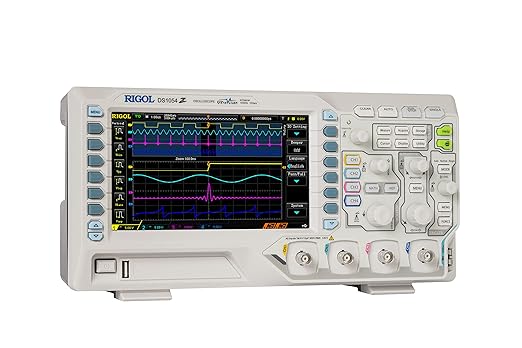The oscilloscope is one of the best devices for analyzing circuits and signals. However choosing the right oscilloscope is crucial because if you choose the wrong oscilloscope, you could pay extra money. If you are new to electronics and don’t know how to choose the best oscilloscope for you, then this step-by-step guide will help you. In this article, I will explain the key factors in choosing the best digital oscilloscope for Hobbyists or Makers.
What is Oscilloscope?
An oscilloscope is a scientific instrument used to visually display and analyze electrical signals over time. It is commonly used in electronics, physics, engineering, and other fields to observe the behavior of electrical circuits and waveforms.
Why do you need an Oscilloscope?
You may need an oscilloscope for various reasons, particularly if you work with electronics, electrical systems, or related fields. Here are some common scenarios where an oscilloscope is useful:
- Signal Analysis: An oscilloscope allows you to visually observe and analyze electrical signals. This is invaluable for understanding the behavior of a circuit, diagnosing issues, and verifying the quality of signals.
- Troubleshooting: When something goes wrong with an electronic circuit, an oscilloscope can help you pinpoint the problem by showing where the signal is distorted, attenuated, or otherwise behaving abnormally.
- Measuring Waveforms: You can use an oscilloscope to measure key characteristics of electrical waveforms, such as voltage amplitude, frequency, phase, and rise/fall times. This information is crucial for designing and testing electronic circuits.
- Testing and Validation: Engineers and technicians use oscilloscopes to validate the performance of electronic devices, ensuring they meet design specifications and standards.
The Key Factors to Choose an Oscilloscope
There are hundreds of types of oscilloscopes available on the market. As a hobbyist or beginner in electronics, you do not need to buy a high-configuration oscilloscope. So, choosing the right oscilloscope is very important because it may save your money and time. There are several factors involved in choosing the right oscilloscope. Here are some key factors to consider before buying an oscilloscope.
Bandwidth:
Bandwidth is the fundamental ability to measure a signal. Always remember the five-time rule. Your oscilloscope must have five times the bandwidth of your signal. For example, if your signal bandwidth is 20 MHz, then your oscilloscope should have a 100 MHz bandwidth.

Sample Rate:
The sample rate of an oscilloscope is almost similar to the resolution of a mobile camera. With a high-resolution camera, you can capture a high-quality image. The sample rate of an oscilloscope determines how accurately it captures a signal. A higher sample rate means a better web form. Choose an oscilloscope that has a five-times greater than your circuit’s frequency components.

Number of Channels:
The number of channels in an oscilloscope determines how many signals it can measure at the same time. Most oscilloscopes come with either two or four channels, although some models can have more than that. Two channels are generally sufficient for beginners, but professionals may find a four-channel oscilloscope more suitable. In situations where complex circuits are involved, oscilloscopes with a higher number of channels may be necessary.

Memory Capacity:
The memory capacity of an oscilloscope refers to the amount of data or samples it can hold. A higher memory capacity in an oscilloscope allows it to capture and display a longer time span of the signal, facilitating a more thorough analysis.
Display:
When choosing an oscilloscope display, consider factors such as display size, resolution, touchscreen vs. traditional interface, color and contrast, waveform persistence, user interface usability, built-in measurements, connectivity options, portability, budget constraints, brand reputation, and user reviews.
Price:
As a hobbyist or beginner, you do not need a high-budget or high-configuration oscilloscope. Compare two or more oscilloscope bands and get the one that is suitable for you.
List of Best Budget Oscilloscopes for Hobbyists and Makers (2024)
| MODEL | BANDWIDTH | NUMBER OF CHANNELS | REAL-TIME SAMPLING RATE | MEMORY DEPTH | PURCHASE LINK |
|---|---|---|---|---|---|
| Siglent SDS1104X-E | 100 MHz | 4 | 1 GSa/s | 14 Mpts | Amazon |
| Hantek DSO2C10 | 100 MHz | 2 | 1 GSa/s | 8 Mpts | Amazon |
| Siglent SDS1202X-E | 200 MHz | 2 | 1 GSa/s | 14 Mpts | Amazon |
| Rigol DS1054Z | 50 MHz | 4 | 1 GSa/s | 24 Mpts | Amazon |
| Hantek 2C72 | 70 MHz | 2 | 250MSa/s | Amazon |
Affiliate Disclosure: When you click on links to make a purchase, this can result in this website earning a commission.
Siglent SDS1104X-E (Bandwidth: 100 MHz, Channels: 4)

Image source: www.amazon.com
As a hobbyist or beginner, you need a reliable and easy-to-use oscilloscope. So, the Siglent Technologies SDS1104X-E digital oscilloscope is the best choice for you. It gives you the best experience in analyzing various signals and circuits. It has lower noise than other oscilloscopes. It has four channels, so you can analyze four different signals at a time.
Specifications:
- Bandwidth: 100 MHz
- Number of Channels: 4
- Real-time sample rate: 1 GSa/s
- Memory depth: 14 Mpts
- Display: TFT Color Temperature Display
Pros:
- Best for multiple signal analysis because of its 4 channels
- Can be controlled by a web page
- High sampling rate
Cons:
- Lower bandwidth (100 MHz)
Siglent Technologies SDS1104X-E Purchase Link: Amazon
Hantek DSO2C10 (Bandwidth: 100 MHz, Channels: 2)

Image source: www.amazon.com
If you want to buy a low-price Oscilloscope with better performance then, the Hantek DSO2C10 is an option. Hantek’s DSO2C10 digital oscilloscope is a versatile tool for analyzing protocols like RS232/RS485, PWM, UART, I2C, SPI, CAN, and LIN, making it ideal for personal hobbies, maintenance, and small-scale laboratory use. This Oscilloscope is beneficial for various fields like communication, embedded systems, computers, research, and education.
Specifications:
- Bandwidth: 100 MHz
- Number of Channels: 2
- Real-time sample rate: 1 GSa/s
- Memory depth: 8 Mpts
- Display: TFT Display
Pros:
- Suitable for both professional and hobbyists
- 32 kinds of auto-measurements
- High sampling rate
Cons:
- Lower bandwidth (100 MHz)
- Less number of channels (2 channels)
Hantek DSO2C10 Purchase Link: Amazon
Siglent SDS1202X-E (Bandwidth: 200 MHz, Channels: 2)

Image source: www.amazon.com
If you need higher bandwidth for analyzing signals then this Siglent Technologies SDS1202X-E digital oscilloscope is a good one. Siglent SDS1202X-E offers powerful features and high performance, unlike similar products in the industry. With a minimum vertical input range of 500 UV/Div, an innovative digital trigger system, and a 256-level intensity Grading display function, these oscilloscopes offer superior performance and low noise compared to others.
Specifications:
- Bandwidth: 200 MHz
- Number of Channels: 2
- Real-time sample rate: 1 GSa/s
- Memory depth: 14 Mpts
- Display: TFT Display
Pros:
- Higher bandwidth (200 MHz)
- Higher sampling rate
- High frequency resolution for observing signal spectra
- Waveform recording history
Cons:
- TFT display
- Less number of channels (2 channels)
Siglent Technologies SDS1202X-E Purchase Link: Amazon
Rigol DS1054Z (Bandwidth: 50 MHz, Channels: 4)

Image source: www.amazon.com
Rigol DS1054Z digital oscilloscope is a low-priced high-performance Digital oscilloscope. It is immensely popular and easy to use. It has a 50 MHz bandwidth with 4 channels which is enough for mid-range signal analysis. If you are a beginner or hobbyist, then this oscilloscope is good for you.
Specifications:
- Bandwidth: 50 MHz
- Number of Channels: 4
- Real-time sample rate: 1 GSa/s
- Memory depth: 24 Mpts
- Display: 7-inch WVGA TFT LCD
Pros:
- Suitable for beginners and hobbyists
- Best for multiple signal analysis because of its 4 channels
Cons:
- Lower bandwidth (50 MHz)
- Lower memory depth
Rigol DS1054Z Purchase Link: Amazon
Hantek 2C72 Handheld Oscilloscope (Bandwidth: 70 MHz, Channels: 2)

Image source: www.amazon.com
Hantek 2C72 Handheld (Oscilloscope + Multimeter) is one of the best handheld digital oscilloscopes for students and hobbyists. You can easily carry this device wherever you want to go. But from a performance point of view, it is the same as other lab oscilloscopes. Also, it has a built-in multimeter, so you don’t need to buy an extra multimeter. Also, you can generate various signals with this multimeter. For example, Sign wave, square wave, etc.
Specifications:
- Bandwidth: 70 MHz
- Number of Channels: 2 + Digital Multimeter
- Real-time sample rate: 250MSa/s
- Memory depth: –
- Display: LCD screen
Pros:
- Very easy to carry
- Suitable for beginners and hobbyists
- Built-in digital multimeter
Cons:
- Lower bandwidth
- Lower memory depth
- Less number of channels
Hantek 2C72 Purchase Link: Amazon
My Recommendation
Overall, all of these oscilloscopes give you better performance. I prefer to buy a high-configuration oscilloscope because it allows you to analyze more than two signals and gives you a wider bandwidth. Therefore, Siglent Technologies SDS1104X-E will be a good option. But if your budget is low then go for Hantek DSO2C10.
You may also like reading:
